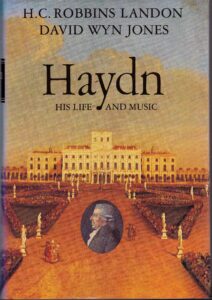The first concert of Orchestra Wellington’s 2023 Inner Visions season takes place this Saturday night at the Michael Fowler Centre. The programme, entitled ‘Fundamental Forces’, presents Prokofiev’s Scythian Suite, C.P.E. Bach’s Symphony in E minor, Stravinsky’s Violin Concerto in D (with soloist Natalia Lomeiko), and Haydn’s Symphony No. 39 in G minor. This powerful confluence of visions and forces, realised through an eclectic programme, prompted us to ask Orchestra Wellington’s Music Director, Marc Taddei, about the connections between these musical works:
‘We see the genesis of the Empfindsamer Stil and Sturm und Drang representing the Dionysian impulse in music (which is the theme of the season), with an example of a kind of apotheosis in the Scythian Suite (a New Zealand premiere, as far as I am aware). I like the idea of CPE Bach’s father being represented by a neo-classic homage by Stravinsky, which … presents the opposing Apollonian impulse.’
– Marc Taddei
So, how to learn more about Empfindsamer Stil (‘the style of sensitivity’), Sturm und Drang (‘storm and stress’), Apollonian rationality, harmony, and restraint, not to mention the unbridled passion and ecstatic excesses of Dionysius? Our collection holds the answers! In this post, we will highlight some material that contextualizes this music and its creators. Firstly, all members of Wellington City Libraries can access to Oxford Music Onlinevia the eLibrary – you just need your card number and PIN to log in. Oxford Music Onlineoffers concise articles about Emfindsamkeit and Empfindsamer Stil, Sturm und Drang, and Neo-classicism. Oxford Music Online also contains biographies of C. P. E. Bach, Haydn, Stravinsky, and Prokofiev.
In addition, there are several books that provide still greater breadth and depth of discussion, all by leading authorities in music history, engaging for general and specialist audiences alike. Our recommendations include:
The beloved vision : a history of nineteenth century music / Walsh, Stephen
Despite its title, Walsh begins the story of The Beloved Vision in the eighteenth century, demonstrating the pivotal role played by C. P. E. Bach and Haydn in the later development of nineteenth-century music. The alternately exquisite and visceral elements of Bach’s Symphony in E minor – exemplifying a sensibility attuned to the eloquent expression of drama and tenderness, the very epitome of Empfindsamer Stil – would find a later and more extreme expression in the Sturm und Drang of Haydn’s Symphony No. 39. Works such as these, Walsh argues, while firmly of the eighteenth century, were some of the earliest expressions of characteristics we’d come to associate with Romanticism. Walsh explores late eighteenth- and early nineteenth-century thought concerning volatile expression in poetry, and how those ideals might find expression in music. Walsh’s discussion of Empfindsamer Stil and Sturm und Drang in their literary and musical manifestations, and as forms of reaction to the confident certainties of Enlightenment, provides useful context for listening to the music of both C.P.E. Bach and Haydn.
The Faber pocket guide to Haydn / Wigmore, Richard
Richard Wigmore’s concise exploration of Haydn’s life and music offers an ideal introduction to the composer, as well as offering insights into his work for the connoisseur. Wigmore discusses a range of Haydn’s work, anatomizing many of the subtle elements of his aesthetics that are often overlooked. The expressive depths of Haydn’s music, which are especially evident in such Sturm und Drang works as his Symphony No. 39, form a significant part of Wigmore’s broader discussion in this useful and comprehensive book.
 Haydn : his life and music / Landon, H. C. Robbins
Haydn : his life and music / Landon, H. C. Robbins
H. C. Robbins Landon’s Haydn: his life and music was one of the first comprehensive critical studies of the composer that explored Haydn on his own terms, considering the different phases of his career, his development as a composer, the struggle of balancing his duties as a Kapellmeister to the Esterhazy princes with his own creative ambitions, and the great fame that he experienced later in his life. This is a scholarly book, minutely researched, but the author used his sources so carefully that it’s also constantly engaging, leading the reader through the vicissitudes and triumphs of Haydn’s life and linking these with his music. One early review of Haydn: his life and music describes the ‘presentation as laconic’ and the author’s tone as ‘infectiously lively’ – qualities that are absolutely appropriate to Haydn himself.
Stravinsky : a creative spring : Russia and France, 1882-1934 / Walsh, Stephen
In the first installment of his two-volume biography of Igor Stravinsky, Stephen Walsh examines the composer’s early life, the development of his career, the extraordinary collaboration with Sergei Diaghilev and the Ballets Russes, and the years in Switzerland and France. Walsh highlights the relationship between Stravinsky’s pragmatism and business sense, his aesthetics, and his identity as a Russian composer outside his mother country. Walsh also explores in fascinating detail the genesis of Stravinsky’s Violin Concerto (1931) – a work of Apollonian balance and clarity – and the controversy the piece provoked. Stravinsky: a creative spring is a meticulously researched biography that brings the enigmatic composer vividly to life.
Sergei Prokofiev : a biography / Robinson, Harlow Loomis
Prokofiev’s Scythian Suite dates from 1915. Its music comes from the score of a ballet that Sergei Diaghilev had commissioned from Prokofiev for the Ballets Russes. Unfortunately, Diaghilev did not accept Prokofiev’s work Ala i Lolli, a story based on ancient Slavic mythology with a proposed scenario by the symbolist poet Sergei Gorodetsky. In the wake of the furore caused by Stravinsky’s score for The Rite of Spring and the drama of its premiere with the Ballets Russes, Prokofiev wanted to create a similar stir, with a similarly Dionysian score. After Diaghilev dropped the project, perhaps because he felt the music was derivative of Stravinsky’s Rite, Prokofiev instead transformed some of the music into the four-movement Scythian Suite, a virtuosic orchestral work that sketches out the storyline of the ballet. The story of Diaghilev’s commission, Prokofiev’s ambitions for the project, and the (small) scandal provoked by the premiere of the Suite are described in Harlow Loomis Robinson’s Sergei Prokofiev: a biography, along with an engaging account of the Suite‘s premiere:
One of those most offended by “The Scythian Suite” was Glazunov, who made a great show of leaving the concert hall eight measurers before the end …. Even the musicians were upset: the timpanist broke through the skin on his timpani, and [a] cellist complained to Prokofiev that he agreed to play only because he had a wife and three children to support.’
– H. L. Robinson


